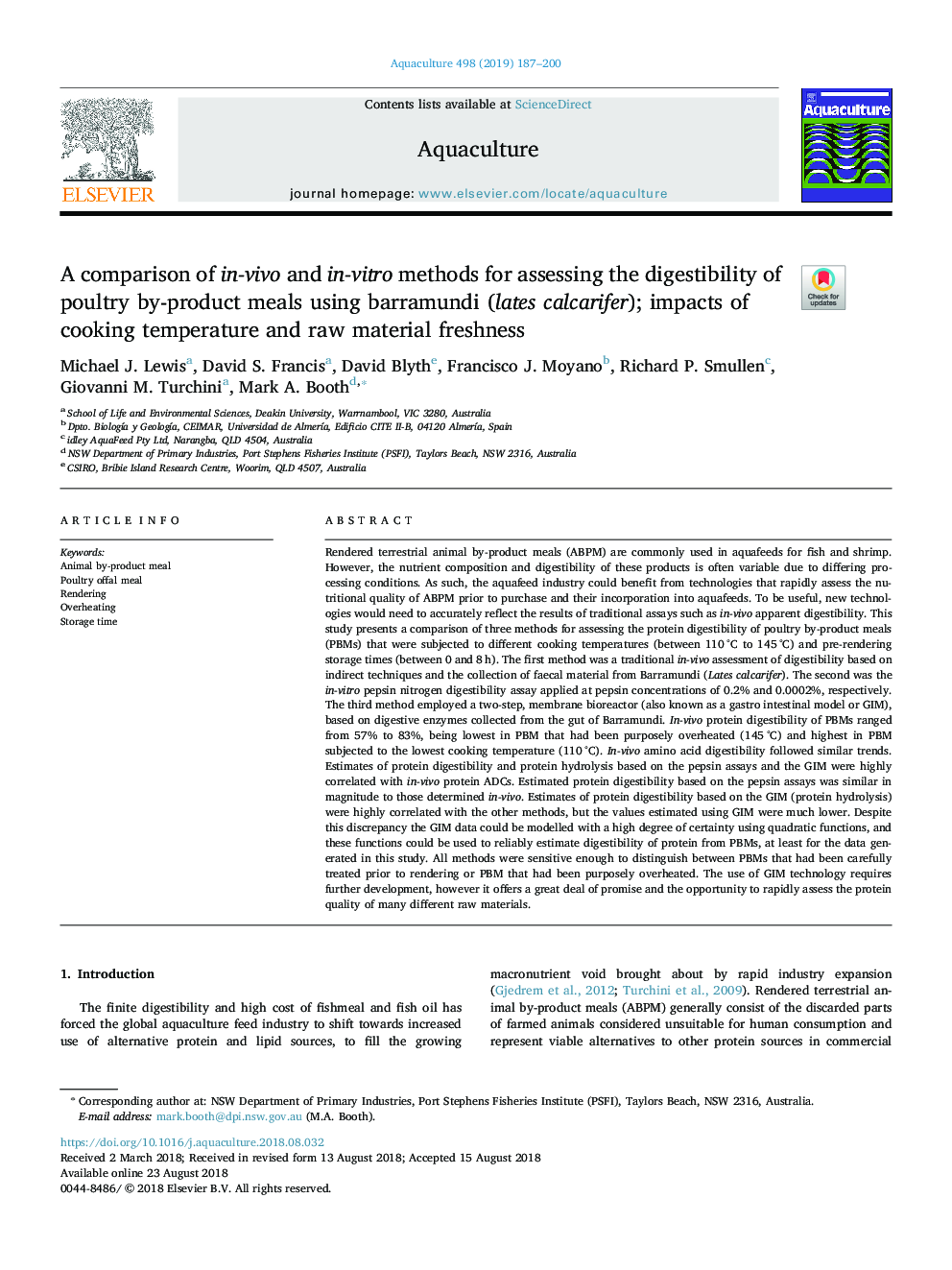| کد مقاله | کد نشریه | سال انتشار | مقاله انگلیسی | نسخه تمام متن |
|---|---|---|---|---|
| 10137305 | 1645731 | 2019 | 14 صفحه PDF | دانلود رایگان |
عنوان انگلیسی مقاله ISI
A comparison of in-vivo and in-vitro methods for assessing the digestibility of poultry by-product meals using barramundi (lates calcarifer); impacts of cooking temperature and raw material freshness
دانلود مقاله + سفارش ترجمه
دانلود مقاله ISI انگلیسی
رایگان برای ایرانیان
موضوعات مرتبط
علوم زیستی و بیوفناوری
علوم کشاورزی و بیولوژیک
علوم آبزیان
پیش نمایش صفحه اول مقاله

چکیده انگلیسی
Rendered terrestrial animal by-product meals (ABPM) are commonly used in aquafeeds for fish and shrimp. However, the nutrient composition and digestibility of these products is often variable due to differing processing conditions. As such, the aquafeed industry could benefit from technologies that rapidly assess the nutritional quality of ABPM prior to purchase and their incorporation into aquafeeds. To be useful, new technologies would need to accurately reflect the results of traditional assays such as in-vivo apparent digestibility. This study presents a comparison of three methods for assessing the protein digestibility of poultry by-product meals (PBMs) that were subjected to different cooking temperatures (between 110â¯Â°C to 145â¯Â°C) and pre-rendering storage times (between 0 and 8â¯h). The first method was a traditional in-vivo assessment of digestibility based on indirect techniques and the collection of faecal material from Barramundi (Lates calcarifer). The second was the in-vitro pepsin nitrogen digestibility assay applied at pepsin concentrations of 0.2% and 0.0002%, respectively. The third method employed a two-step, membrane bioreactor (also known as a gastro intestinal model or GIM), based on digestive enzymes collected from the gut of Barramundi. In-vivo protein digestibility of PBMs ranged from 57% to 83%, being lowest in PBM that had been purposely overheated (145â¯Â°C) and highest in PBM subjected to the lowest cooking temperature (110â¯Â°C). In-vivo amino acid digestibility followed similar trends. Estimates of protein digestibility and protein hydrolysis based on the pepsin assays and the GIM were highly correlated with in-vivo protein ADCs. Estimated protein digestibility based on the pepsin assays was similar in magnitude to those determined in-vivo. Estimates of protein digestibility based on the GIM (protein hydrolysis) were highly correlated with the other methods, but the values estimated using GIM were much lower. Despite this discrepancy the GIM data could be modelled with a high degree of certainty using quadratic functions, and these functions could be used to reliably estimate digestibility of protein from PBMs, at least for the data generated in this study. All methods were sensitive enough to distinguish between PBMs that had been carefully treated prior to rendering or PBM that had been purposely overheated. The use of GIM technology requires further development, however it offers a great deal of promise and the opportunity to rapidly assess the protein quality of many different raw materials.
ناشر
Database: Elsevier - ScienceDirect (ساینس دایرکت)
Journal: Aquaculture - Volume 498, 1 January 2019, Pages 187-200
Journal: Aquaculture - Volume 498, 1 January 2019, Pages 187-200
نویسندگان
Michael J. Lewis, David S. Francis, David Blyth, Francisco J. Moyano, Richard P. Smullen, Giovanni M. Turchini, Mark A. Booth,